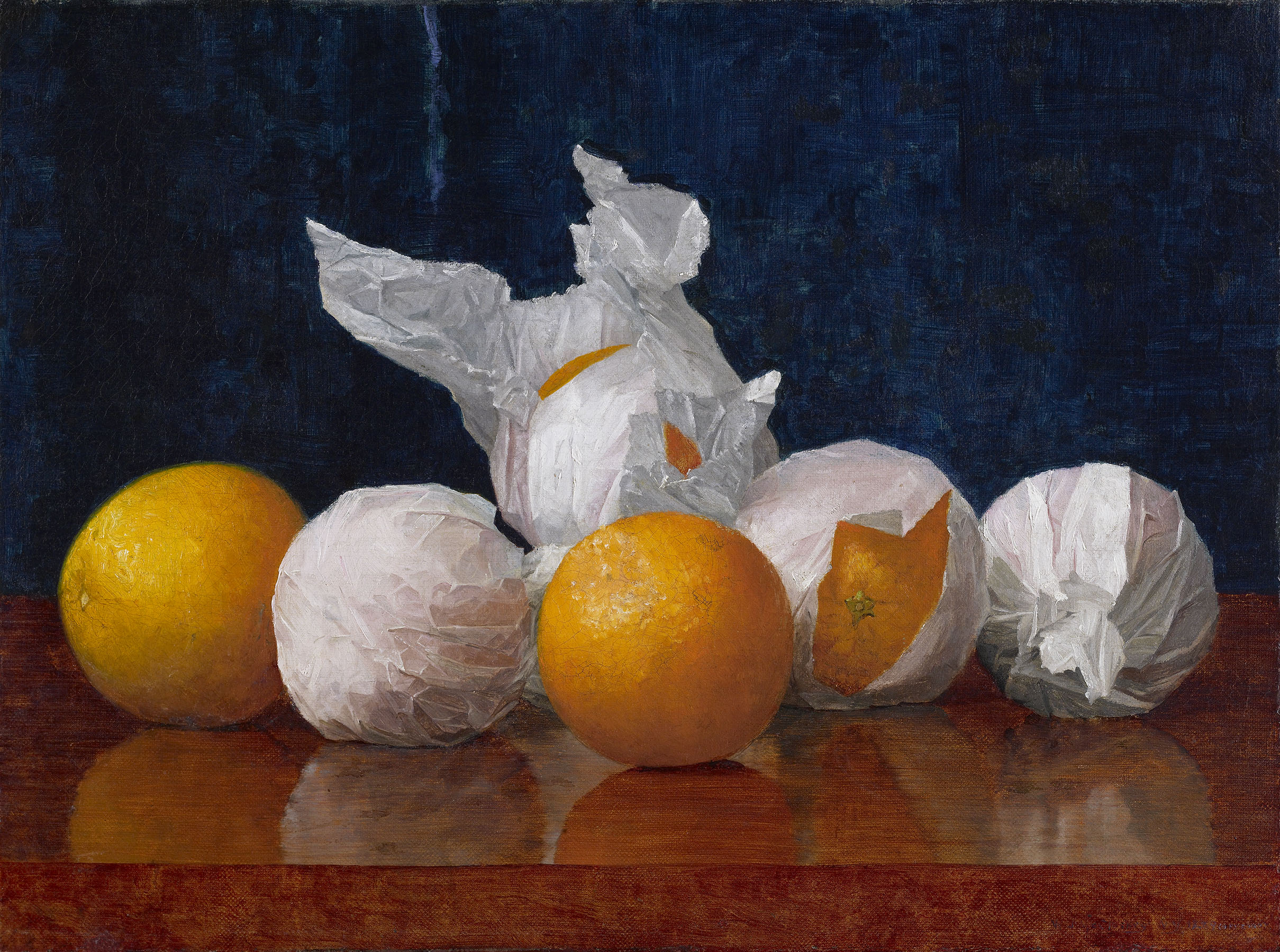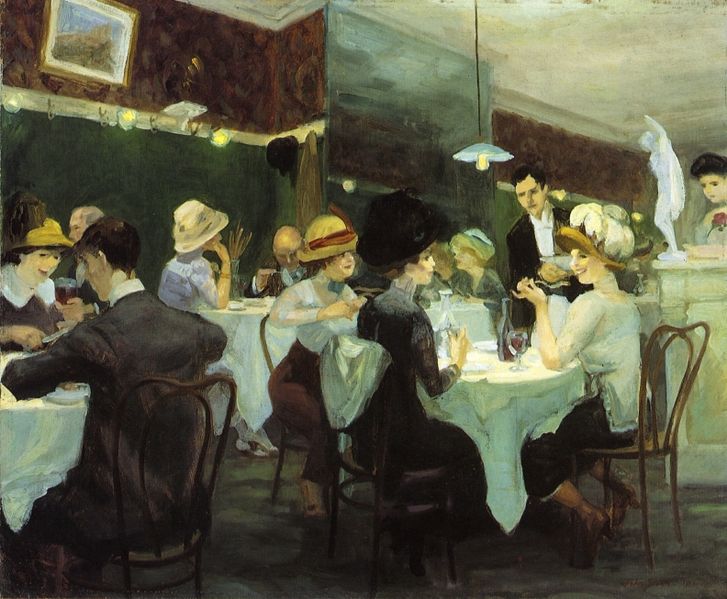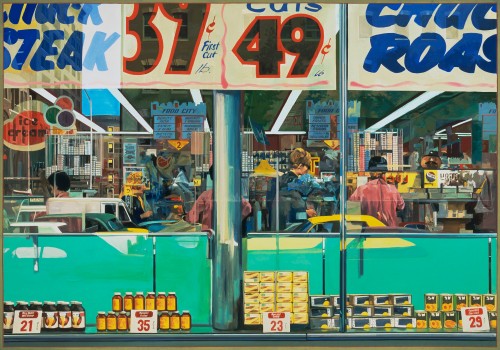American art with the opening of the major exhibition Exploring the many meanings and interpretations of eating in Art and Appetite: American Painting, Culture, and Cuisine on view from November 12, 2013 through January 27, 2014 at the Art Institute of Chicago —brings together 100 paintings, sculptures, and decorative arts from the 18th through the 20th century to demonstrate how depictions of food have allowed American artists to both celebrate and critique everything from the national diet to society and politics.
Following its premiere at the Art Institute, Art and Appetite: American Painting, Culture, and Cuisine will travel to the Amon Carter Museum of American Art in Fort Worth, Texas (February 22–May 18, 2014).
Art and Appetite takes a new approach to American paintings of food, contextualizing them to rediscover the meanings they held for their makers and their public. Despite the prevalence of such works, research has rarely focused on the cultural significance of the objects depicted in these paintings, nor has it addressed how these paintings embodied changing ideals throughout the nation’s history. Thematically and chronologically organized, Art and Appetite breaks with the traditional histories of the genre to explore how it illuminates American attitudes about patriotism and politics, identity and gender, progress and history, and production and consumption.
The exhibition examines the agricultural bounty of the “new world,” Victorian-era excess, debates over temperance, the rise of restaurants and café culture, the changes wrought by 20th-century mass production, and much more—all represented in American art spanning 250 years. A wealth of fascinating materials are also showcased in the exhibition, including menus, cookbooks, advertisements, and decorative arts.
From the earliest years of the United States, American artists such as Raphaelle Peale used stilllife painting to express cultural, political, and social values, elevating the genre to a significant aesthetic language. Later, in antebellum America, depictions of food highlighted abundance, increasing wealth, and changing social roles, while elegant decanters of wine and spirits in stilllife paintings by John F. Francis reflected the prevalence of drinking and the mid-century debates over temperance. During the Gilded Age, despite the implications of the term, American artists moved away from excess and eschewed high Victorian opulence in favor of painting the simple meal. Many artists, such as William Harnett or De Scott Evans, also used food pictures to serve up biting political commentary that addressed the social and economic transformations of the 1880s and 1890s.
In the 20th century new ways of eating and socializing began to change depictions of food in art. Restaurant dining—still novel in the United States in the late 19th century—became a common subject in the works of William Glackens, John Sloan, and others. Café and cocktail culture, described in the work of Stuart Davis and Gerald Murphy, became increasingly important even as Prohibition banned the consumption of alcohol. Modernist artists employed food in their radically new explorations of pictorial form, all the while challenging national ideals of family and home. Finally, during the 1950s and 1960s, Pop artists, among them Andy Warhol and Claes Oldenburg, addressed the ways in which mass production and consumption dramatically altered the American experience of food. Hamburgers, fries, and cakes were depicted as objects of mass-produced comestibles without human referent. Artists employed new means to explore the visual power of advertising, the standardization of factory-produced meals, and the commercialization of American appetites.
Today, as professional and home chefs increasingly turn toward local, organic food and American society ponders its history as a fast-food nation, this exhibition on the historical art of eating is highly relevant, offering visitors the chance to look at depictions of American food and culture with new meaning and fresh eyes.
From a nice review:
The exhibit opens with a timely ode to what is perhaps the most food-centric holiday in American culture: Thanksgiving. Here, the oft-seen Norman Rockwell painting Freedom from Want occupies pride of place in a testament to the American values of abundance and prosperity in a postwar era.
Barter takes viewers on a journey across two centuries of culinary pictorial history in the following galleries. On display are paintings by the pioneering American artist Raphaelle Peale, whose still lifes reflect the bounties of the earth and the native beauty of the new Republic. While the moral overtones in his work are few, relative to his European counterparts, Peale nonetheless imbues his paintings with allusions to the themes of self-sustainment and Republican virtue. It is worth a visit to the exhibition for the sole purpose of viewing the still lifes, since the highly realistic depictions are enough to make your mouth water.
The exhibit also showcases new ways of eating as a reflection of the changing times. On view are several representations of picnic parties set in nature. At a time when urban centers saw marked growth, the pastoral repast represented a retreat from the hustle and bustle of city life. As the urban population grew, so too did the culture of dining out. In
Renganeschi’s Saturday Night,
John Sloan offers a look at the new restaurant culture that offered the newly affluent the chance to see and be seen and the changing role of women in the early twentieth century.
And from another review: (some images added)
From this country’s earliest years, American artists have used still-life painting to express cultural, political and social values, elevating the subject to a significant artistic language. The topic of food allowed American artists both to celebrate and critique their society, expressing ideas relating to politics, race, class, gender, commerce, and how these categories define American identity.
Art and Appetite includes many iconic works such as
Nighthawks (1942) by Edward Hopper,
Campbell’s Soup (1965) by Andy Warhol.
Food City by Richard Estes (b. 1932)
Fishermen’s Last Supper, Nova Scotia, 1940-41 by Marsden Hartley (1877-1943)
And from still another review:
Doris Lee, "Thanksgiving" (1935)
"It may be hard to fathom today how Lee's colorfully cheerful depiction of food preparation was offensive... . The picture was popular with the public, as was Grant Wood's more famous American Gothic, purchased by the Art Institute in 1930. Both pictures represent historical themes using the imagery of ordinary people and farm life; both enshrined with irony and humor an American past fast disappearing. But by 1935 the depiction of Thanksgiving as a rustic social gathering seemed boorishly common." (Art and Appetite catalog p. 41)
I love the kitchen in this picture with all the activity of many women cooking, except for the one who has obviously just arrived and is taking off her hat. I love the little kids, the dog under the stove, and the cat under the table. The preparation for each traditional element of Thanksgiving dinner is wonderful: the turkey being basted, pie dough being rolled out, vegetables in a basket, pots simmering on top of the old black stove, dishes being taken from a high shelf where no doubt they spend most of the year.
Alice Neel, "Thanksgiving" (1965)
"... the bird collapses in the kitchen sink, looking as though it had just been thrown from the guillotine. Its legs splayed akimbo, its body bloody and pimply, it drains alongside Ajax, sponges, soap, and the breakfast dishes. Neel said of her picture that she painted it while the bird ... ws thawing in the sink and that it was her answer to Pop Art." (Art and Appetite, p. 51)
My own feeling is that this image of an absolutely typical kitchen from the 1960s is now as much nostalgic as the famous Norman Rockwell grandmother and grandfather with a turkey or the painting by Doris Lee above. Who hasn't seen the exact water faucet, Ajax can, and metal cabinet handles along with the white porcelain of mother's or grandmother's or aunt's kitchen sink?
More images from the exhibition:

James Peale’s “Still Life: Balsam Apple and Vegetables,”

William J. McCloskey. Wrapped Oranges, 1889. Amon Carter Museum of American Art, Fort Worth, Texas, Acquisition in memory of Katrine Deakins, Trustee, Amon Carter Museum of American Art, 1961-1985.

Wayne Thiebaud. Salad, Sandwiches and Dessert, 1960. Lent by the Sheldon Museum of Art, University of Nebraska-Lincoln, NAA-Thomas C. Woods Memorial. © Wayne Thiebaud/Licensed by VAGA, New York, NY.

Roy Lichtenstein’s turkey
























